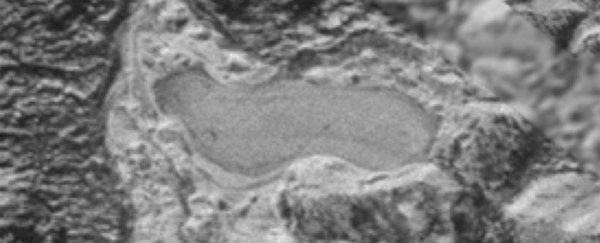It's been several months since New Horizons made its historic flyby of Pluto, but the probe is still only halfway through transmitting the huge amounts of data it recorded at the time back to NASA headquarters.
Among the latest findings presented by the space agency this week is evidence suggesting that the frozen liquid nitrogen that covers much of the dwarf planet's surface might not always have been so icy still. NASA thinks changes in Pluto's atmospheric pressure over time could have resulted in this frozen mass thawing into flowing liquid in the past – a hypothesis supported by various surface details spied by New Horizons, such as this "frozen, pond-like feature just north of Sputnik Planum".
"Liquids may have existed on the surface of Pluto in the past," New Horizons Principal Investigator Alan Stern told the media on Monday at the Lunar and Planetary Science Conference in Texas. "We see what for all the world looks to a lot of our team like a former lake."
According to the scientists, the flat, featureless appearance of the object in the image below – which starkly contrasts with the jagged terrain surrounding it – makes it likely that we're looking at a lake of liquid nitrogen, frozen in place since a warmer chapter in Pluto's history.
"It's very smooth, as if a liquid has frozen across one height," Stern told New Scientist. "It's hard to come up with an alternate model that would explain that morphology."
But given that Pluto's orbit sees it located several billion kilometres from the Sun – with an average current surface temperature of –229 degrees Celsius (–380 degrees Fahrenheit) – when exactly does it get balmy enough for the frozen liquid nitrogen to melt? The answer, according to NASA, is to do with the tilted and slightly changing angle at which Pluto orbits the Sun, together with the extensive duration of its 248-year orbit.
 NASA/JHUAPL/SwRI
NASA/JHUAPL/SwRI
During this lengthy circuit of the Sun, and depending on the exact orbital angle at which it's tilted, NASA says Pluto is subjected to extreme shifts in atmospheric pressure, with simulations suggesting that it can reach 20,000 times the pressure of current readings. This ends up affecting the surface temperature, and – if NASA is correct – making the frozen liquid nitrogen masses melt into flowing lakes and rivers.
Not that this happens very often. According to the scientists' calculations, the last time this would have occurred was some 800,000 years ago when the dwarf planet's axial tilt reached 103 degrees. Right now, Pluto is in an intermediate phase between its climate extremes, meaning it will be a long time before it happens again.
The New Horizons team delivered nearly 40 scientific papers this week at the Lunar and Planetary Science Conference based on data from the probe, and it's amazing to think we've only seen half of what's been recorded. We can't wait to see what else is on the way.
